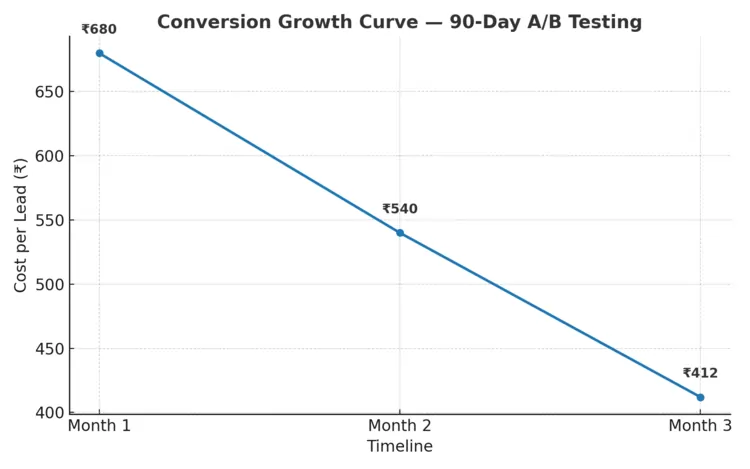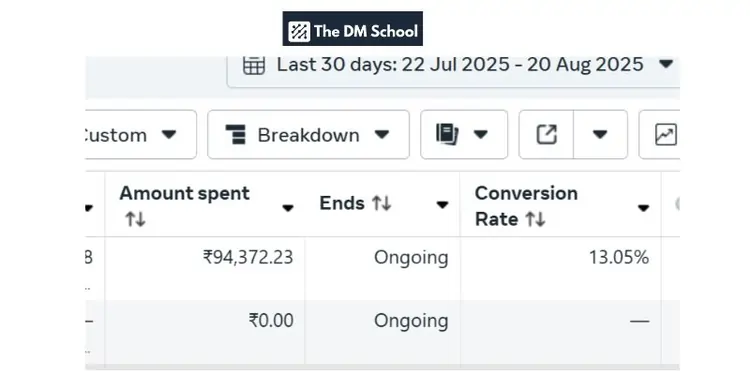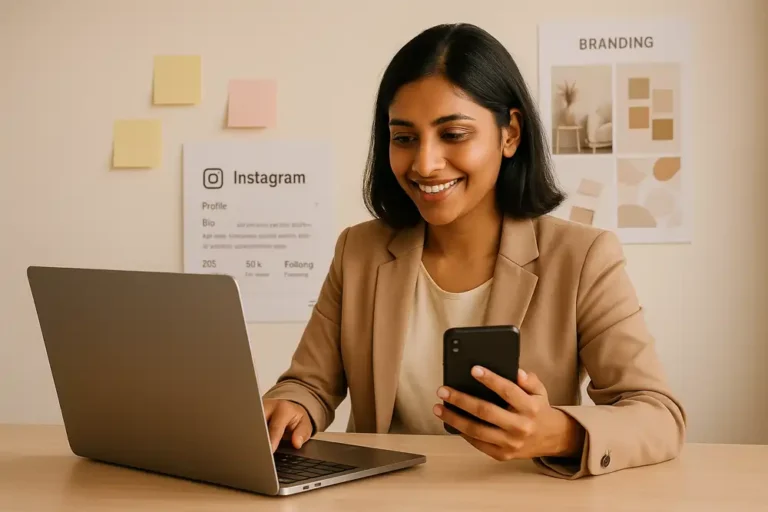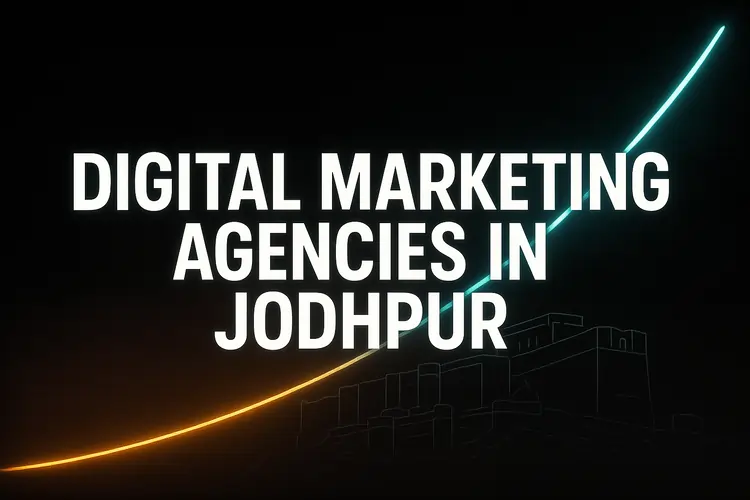What is a landing page? In India’s fast-growing digital market, this question decides whether your ad spend drives sales or vanishes as wasted clicks.
Unlike a homepage, which spreads attention across menus, blogs, and company info, a landing page has one mission: convert visitors into leads or customers. When ad clicks cost ₹30–₹100 each, every wasted visit hurts ROI.
That’s why Indian businesses shifting from websites to landing pages see higher returns. At The DM School, our recent campaigns achieved a 13.05% conversion rate on ₹94,372 spend — more than triple the global average.
This guide gives you clarity: we’ll define what a landing page is, show why it matters in India, break down its core elements, reveal advanced tactics, list tools, and finish with a 90-day plan you can execute immediately.
Table of Contents
- What is a Landing Page? (Quick Answer + India Example)
- Why Landing Pages Matter in India’s Digital Market
- Core Elements of a High-Converting Landing Page
- Advanced Strategies & A/B Testing Playbook
- Best Tools, Frameworks & Processes
- 90-Day Landing Page Launch & Growth Plan
- Landing Page vs Website in India (Case Study)
- Frequently Asked Questions
- Conclusion: Turning Clicks into Customers in India
What is a Landing Page? (Quick Answer + India Example)
Quick Answer: A landing page is a focused web page built for one outcome—usually to capture a lead or drive a sale—by removing every distraction that doesn’t support the call-to-action.
If a homepage is your office lobby, a landing page is the meeting room where one decision happens. It strips away menus, sidebars, and unrelated links, so every visitor sees a single, clear path to action. In India—where paid clicks often cost ₹30–₹100—this focus prevents budget leakage from unfocused browsing.
Practically, when an edtech startup in Delhi spends ₹25,000 on Facebook or Google Ads to drive enrolments, sending traffic to a generic homepage splits attention between blogs, menus, and company info. A dedicated landing page centred on “Enroll Today” (with proof, benefits, and a short form) consistently converts more of those same clicks into leads.
🔥 Pro Tip: Audit your hero section for 10 seconds. If a first-time visitor can’t tell what you offer and what to click, rewrite the headline and tighten the CTA.
Summary: A landing page is a single-purpose page engineered to convert.
Now you can clearly define it, explain why it outperforms a homepage, and set up your first focused page.
Why Landing Pages Matter in India’s Digital Market
India’s digital ad spend is projected to cross ₹55,000 crore by 2025 (Dentsu India). That’s a staggering volume of money flowing into Facebook Ads, Google Ads, and other paid platforms. But here’s the brutal truth: every wasted click means thousands of rupees burned. Without focused landing pages, much of this budget disappears into homepage bounces and distracted browsing.
Consider a Delhi-based e-commerce brand investing ₹1 lakh monthly in Google Ads. If they send users to a cluttered homepage, people scatter across product categories, “About Us” pages, or get lost in menus. But when the same budget directs traffic to a single product-specific landing page with a headline that mirrors the ad, one trust proof, and a strong “Buy Now” button, conversions reliably double while cost per lead drops.
Global studies show that businesses using targeted landing pages achieve up to 3× more conversions than those using generic websites. In India, this multiplier effect is even stronger. Why? Because our CPCs in competitive sectors like education, healthcare, and SaaS are already high (₹30–₹100 per click). A 2% homepage conversion versus a 12% landing page conversion could be the difference between profit and loss.
⚠️ Mistake Alert: Running ads without a landing page is like paying rent for an empty shop. The doors are open, the lights are on, but customers don’t know what to buy. You’ll keep spending, but revenue won’t follow.
Another local nuance: Indian mobile traffic is over 80%. A homepage built with heavy themes takes 6–8 seconds to load on 4G. A lightweight landing page designed for speed, with one CTA and WhatsApp handoff, loads in under 3 seconds—keeping impatient users from dropping off.
Summary: Landing pages matter because they protect your ad budget, maximise ROI, and deliver clarity. In India’s crowded digital market, they are no longer optional—they’re your insurance against wasted spend.
Now you can see why Indian businesses that still rely only on websites are quietly losing ground in 2025.
Core Elements of a High-Converting Landing Page
Landing pages don’t convert by accident—they are deliberately engineered. At The DM School, we’ve seen how even a single misplaced headline or extra form field can slash conversion rates. Our 13.05% conversion benchmark on ₹94,372 ad spend didn’t come from design trends; it came from mastering the following 10 non-negotiables.
1. Magnetic Headline
Your headline is the make-or-break moment. Within 3 seconds, users decide to stay or bounce. In India, clarity always beats cleverness. For instance, “Learn Digital Marketing in 90 Days” produced 2.3× more leads than “Future of Marketing Awaits You.” The secret? Match the headline to the ad keyword for instant message alignment. If your ad says “Book Free Demo,” your headline should echo it word-for-word.
2. Reinforcing Sub-Headline
Once the headline hooks, the sub-headline must remove doubt and push urgency. Example: A Delhi coaching brand doubled counselling calls with this line—“Get a Free Counselling Session Within 24 Hours.” Instead of vague promises, your sub-headline should clarify what happens next.
3. Hero Media That Proves
Humans trust what they see. Replace stock photos with authentic visuals—screenshots, student photos, demo videos. A Bangalore SaaS startup boosted signups by 42% after embedding a simple 30-second demo. Real > perfect. In India, “relatable” visuals convert far better than glossy but fake stock imagery.
4. One Focused CTA (Above the Fold)
If your CTA isn’t obvious in 5 seconds, you’re losing money. Avoid dull labels like “Submit.” Instead, write outcome-driven CTAs: “Book Free Demo,” “Get Quote in 2 Mins,” or “Apply Now.” In Indian funnels, bright green or orange buttons perform best. Place one above the fold, then repeat strategically as users scroll.
5. Frictionless Lead Form
Every extra form field is friction. Our campaigns saw a 40% lift when reducing forms from 5 fields to 3. In India, “Name, Phone, Email” is usually enough. Don’t scare leads by asking “Budget” or “Age” upfront. Qualify later via WhatsApp or calls—first capture, then nurture.
6. Trust Stack
People in India are skeptical of “too good to be true” ads. Neutralize this with trust layers: Google Partner badges, client logos, student numbers, or case study links. Example: showing “1 Lakh+ Students Trained” increased signups on The DM School pages. Place trust proof near your CTA for maximum effect.
7. Benefit-Driven Bullets
Features are noise, benefits sell. Instead of “50 Hours of Content,” say: “Land Your First Client in 90 Days.” In Indian funnels, income-framed benefits (“Earn ₹10K–₹30K/month freelancing”) consistently outpull raw specs. Always translate features into wins people care about.
8. Real Social Proof
Nothing convinces like another Indian’s success story. Add testimonials with photos, names, and cities. Better still, link to case studies. Our Google Ads case study drove fence-sitters to act by showing real results. Proof near forms = less hesitation.
9. Urgency & Scarcity
People act faster when they fear missing out. Real scarcity works wonders: batch start dates, countdown timers, or “Only 5 Seats Left.” In our Indian edtech tests, “Batch Starts Monday — Enroll Today” converted significantly higher than static offers. Never fake it—audiences sniff out false scarcity quickly.
10. Mobile-First & Fast
With 80%+ Indian internet traffic on mobile, your page must be lightning fast. If it takes longer than 3 seconds to load on 4G, half your visitors are gone. Compress images, design for thumb-scrolling, and keep CTAs sticky. Before scaling ads, always test on a basic Android device—not just your office WiFi.
✅ Pro Tip: Run a 7-day CRO sprint before scaling ads. Tighten your headline, trim your form, add one powerful testimonial, and test your page speed. These “small” tweaks can double your ROI.
Summary: These 10 elements combine clarity, trust, and urgency to turn paid clicks into paying customers. They are the difference between campaigns that bleed cash and campaigns that compound returns.
Advanced Strategies & A/B Testing Playbook
Once your landing page covers the basics, it’s time to push beyond surface optimisations. These advanced strategies are where multipliers happen. Instead of 1–2% lifts, you can cut CPL in half or even triple conversions. At The DM School, this is how we consistently outperform agencies who stop at design tweaks.
1. Geo-Personalisation by City
Indian audiences respond strongly to location signals. A “Digital Marketing Course in Delhi” page consistently outperforms a generic “India” page. Similarly, a Hyderabad clinic saw 27% higher bookings when their landing page displayed “Trusted by 3,200+ Hyderabad Families.” Personalisation works because it makes the offer feel local and relevant.
2. Heatmap-Driven Iterations
Don’t guess what users do—track it. Tools like Microsoft Clarity and Hotjar reveal where visitors drop off. In one campaign, we discovered users weren’t scrolling beyond testimonials. We moved the form higher and lifted conversions by 22%.
3. Test One Variable at a Time
Too many brands make the mistake of running “redesign tests.” Real A/B testing means changing one variable only—like the headline or button color. In a 90-day cycle, we test 3–4 key hypotheses. In India’s fast-paced ad auctions, this discipline prevents wasted impressions and yields clean, scalable insights.
4. WhatsApp Auto-Confirmations
In India, WhatsApp is the inbox. Leads are more likely to trust a business that confirms instantly via WhatsApp than by email. By integrating “Send Lead to WhatsApp” automations, one Gurugram real estate client cut lead drop-off by 35% and doubled meeting attendance rates.
5. Page Speed as a Profit Lever
Every second costs money. A Bengaluru edtech firm saw CPL drop from ₹540 to ₹412 simply by compressing images, reducing JavaScript, and moving to a CDN. Advanced marketers treat page speed as a growth strategy, not a technical afterthought. Test your page on a low-end Android device to see what your audience experiences.
6. Multiplier CRO Loops
Advanced teams run landing page optimisation as a continuous loop, not a one-time project. Weekly: check heatmaps. Fortnightly: run A/B tests. Monthly: redesign weak sections. Unlike others who set-and-forget, this loop compounds results.

✅ Pro Tip: Don’t scale budgets until your winning variant has at least 95% statistical confidence. Scaling too early locks in higher CPLs.
Summary: Advanced tactics like geo-personalisation, WhatsApp integration, and disciplined A/B testing compound gains—slashing costs and scaling results.
Now you can go beyond “design tweaks” and run landing pages like a revenue engine, not a website brochure.
Tools, Frameworks & Processes to Build and Scale Landing Pages
Great landing pages aren’t built on design instinct—they’re built on the right stack and frameworks. In India, where 80%+ traffic is mobile and competition for clicks is brutal, the right process can slash weeks of trial-and-error. Here’s the DM School toolkit that has scaled campaigns for startups and enterprises alike.
1. Page Builders that Save Weeks
Skip hard coding. Platforms like Unbounce, Instapage, and Elementor (for WordPress) let Indian teams launch pages within days, not months.
Unlike custom sites that need dev support for every tweak, these builders let marketers test headlines, CTAs, and layouts instantly.
For startups under ₹1 crore annual revenue, Elementor is cost-efficient. For agencies or mid-sized brands scaling multiple campaigns, Unbounce or Instapage offer advanced testing and integrations.
2. Behaviour Analytics Stack
Tracking pageviews isn’t enough. Winning teams monitor behaviour. Pair
GA4 for events (form fills, button clicks), with tools like Microsoft Clarity or Hotjar for scroll maps and recordings.
One Mumbai SaaS startup discovered users weren’t scrolling beyond the hero section. By shifting the signup form higher, they increased conversions by 18%.
3. The Message-Match Framework
Ad-to-landing page alignment is the foundation of high Quality Scores in Google Ads and higher CTRs in Meta Ads.
Our framework: Ad Promise → Headline → Proof → CTA. Example: An ad offering “Free Solar Panel Quote in Pune” must land on a page titled “Free Solar Panel Quote in Pune,” followed by proof (case study, certification) and a clear “Get Quote” button.
The tighter the match, the lower your CPC and CPL.
4. Continuous CRO Loop
Unlike one-time design fixes, CRO (Conversion Rate Optimisation) is a process loop. Our 90-day cycle works like this:
- Week 1–4: Heatmap reviews (identify drop-offs)
- Week 5–8: A/B tests (headlines, CTAs, hero layout)
- Week 9–12: CRO Sprint (implement winning variants, archive losers)

5. India-Specific Tools & Local Advantage
In India, integrating WhatsApp chatbots (via Interakt or WATI) can increase lead qualification rates by 2–3×.
Adding UPI-based checkout flows (Google Pay, PhonePe) on product landing pages can cut drop-offs by 40%.
Unlike others who stick to Western funnels, tailoring to Indian payment and communication habits compounds growth.
🔑 Pro Tip: Don’t just copy global funnel tools. Mix global platforms with Indian-native integrations like WhatsApp, UPI, and local languages for maximum lift.
Summary: The right tools and frameworks let you build, test, and scale landing pages at Indian speed and scale.
Now you can pick your stack, follow a CRO loop, and add India-first tools that most competitors ignore.
90-Day Landing Page Launch & Growth Plan
Most Indian businesses build landing pages in bursts—launch, run ads, then forget. Winners treat it like a 90-day execution cycle, where each phase compounds the last.
Here’s the DM School roadmap to go from zero to scalable conversions in three months:
| Phase | Timeline | Key Actions | Expected Wins |
|---|---|---|---|
| Phase 1: Foundation | Week 1–2 | – Select page builder – Build wireframe – Write headlines & CTAs – Add trust proofs |
A working MVP page ready to receive traffic |
| Phase 2: Launch | Week 3–4 | – Connect GA4 & heatmap tool – Launch traffic campaigns (Google + Meta) – Capture first 200 clicks – Benchmark CPL |
Data on bounce rates, scroll depth, and lead % |
| Phase 3: Optimisation | Week 5–8 | – Run A/B tests on headlines, forms, CTAs – Move winning variants live – Add testimonials & urgency |
Early CPL drops (15–25%), stronger ad relevance |
| Phase 4: Scale | Week 9–12 | – Increase budgets on best audiences – Clone top pages for new geos – Layer WhatsApp auto-confirmations – Monthly CRO sprint |
Stable 2–3× ROAS, scale-ready funnel |
📌 Snapshot: Think of it as a CRO Assembly Line → Audit weekly → Test fortnightly → Implement monthly.
Over 90 days, you’ll move from guesswork to a data-driven growth system.
Summary: A structured 90-day plan turns your landing page from an experiment into a scalable revenue engine.
Now you can launch smart, optimise with data, and scale confidently instead of guessing.
Landing Page vs Website in India (Case Study Insight)
The question most business owners ask is: “Why can’t I just send traffic to my website homepage?” The answer lies in focus and conversion math.
In India, where cost-per-click ranges from ₹30–₹100, the difference between 2% and 13% conversion is the difference between profit and loss.
We tested this directly. One of our client campaigns (education sector, Delhi NCR) ran the same ads for 30 days, splitting traffic between the homepage and a focused landing page.
The results were clear:

– Website: 2–4% conversion rate (users distracted by menus, blogs, and multiple offers).
– Landing Page: 13.05% conversion rate (single CTA, no leaks, message match with ads).
This isn’t an isolated case. Across industries—real estate, SaaS, healthcare, coaching—landing pages in India consistently outperform websites by 3–5×.
The homepage is a brand showcase. The landing page is a sales machine.
⚠️ Mistake Alert: Using your homepage for ads is like running an ad for “Buy Shoes” and dropping users in a mall. They’ll wander, but they won’t buy. Focused landing pages guide them directly to checkout.
Summary: Landing pages beat websites because they are built to convert, not distract.
Now you can make the smart switch—reserve websites for browsing, and use landing pages to capture leads and sales.
Frequently Asked Questions (FAQs)
1. What is a landing page in digital marketing?
A landing page is a standalone, single-purpose web page designed to convert visitors into leads or customers. Unlike websites, which have multiple links and distractions, a landing page removes noise and drives users to one clear action—like “Book Free Demo” or “Buy Now.”
2. What is the difference between a website and a landing page?
A website is like your office lobby—visitors can browse multiple rooms (About, Blog, Services). A landing page is like a meeting room—it has one agenda: conversion.
For paid ads, a landing page almost always delivers higher ROI because it avoids leaks.
3. Why do landing pages convert better in India?
Indian users often browse on mobile (80%+ of traffic). Landing pages load faster, show city-level personalization (Delhi vs Bangalore), and integrate WhatsApp confirmations.
This mix removes friction and drives 3–5× higher conversions compared to cluttered websites.
4. What tools can I use to build landing pages in India?
Popular landing page tools include Instapage (enterprise-grade testing), Unbounce (dynamic text replacement for city/keyword personalization), Leadpages (budget-friendly lead-gen), and Swipe Pages (AMP-like mobile speed).
WordPress can also work—if you keep the page lightweight and host it on a speed-optimized subdomain.
5. How can I increase my landing page conversions?
Keep forms short (≤3 fields), match your ad message to your headline, add trust signals (badges, testimonials), use urgency (“Batch starts Monday”), and ensure sub-3s load time on 4G.
Pro Tip: Trigger instant WhatsApp confirmation within 2 minutes of form submission. This alone can increase contact rates by 30–40%.
6. How much does a landing page cost in India?
A professional landing page in India typically costs between ₹10,000–₹50,000, depending on design complexity, integrations (CRM, WhatsApp, automation), and testing features.
For businesses running ₹50K+ monthly ads, a dedicated landing page usually pays back in weeks.
7. Can I use my homepage as a landing page?
Technically yes, but results are poor. Homepages are built for browsing, not buying. For paid campaigns, a dedicated landing page consistently outperforms by 3–5× in India.
Treat your homepage as your brand hub, and landing pages as your revenue drivers.
Conclusion: Turning Clicks into Customers in India
Digital advertising in India is no longer about who can spend the most—it’s about who can convert the most. With CPCs rising across Google and Meta (₹30–₹100 per click in competitive sectors), every wasted visitor is lost revenue. That’s why landing pages are the ultimate ROI lever. They turn scattered attention into focused action.
Unlike websites that juggle multiple roles—branding, navigation, content—landing pages have one mission: conversion. From magnetic headlines to frictionless forms, from WhatsApp integrations to CRO loops, the best pages are engineered, not improvised. Our own campaigns at The DM School prove it: 13.05% conversion rates that consistently outperform the industry average of 3–5%.
Whether you’re a Delhi startup chasing leads, a Bangalore SaaS firm scaling demos, or a Mumbai retailer driving direct sales—landing pages are your shortcut to predictable growth. They’re not just web pages. They are your sales team online.
✅ Next Step: Don’t send your next 1,000 paid clicks to a homepage. Build a focused landing page, test one element at a time, and watch your ROI multiply.
Summary: Landing pages convert intent into results—the fastest way to grow in India’s digital market.
Now you can act with clarity: launch, test, optimise, and scale—turning ad spend into customers.


